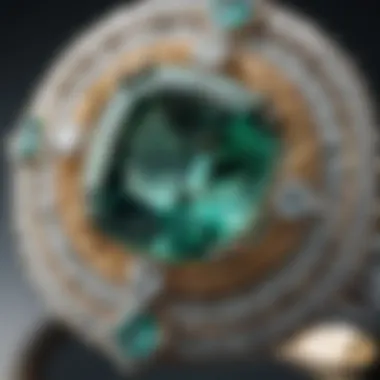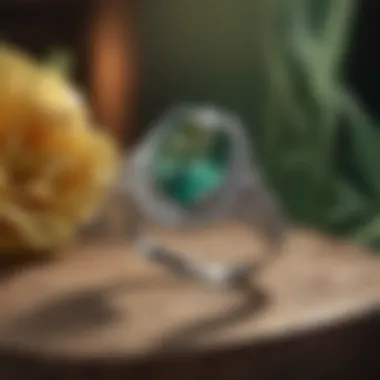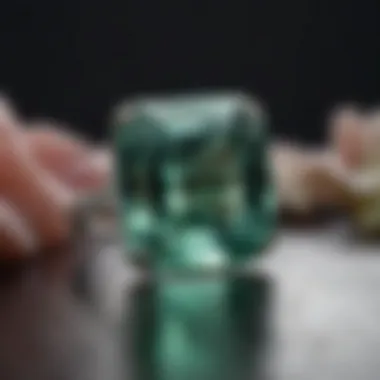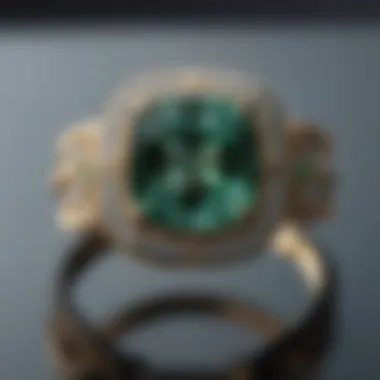Exploring the Allure of Mint Tourmaline Engagement Rings


Intro
Mint tourmaline is gaining traction in the jewelry market, especially for engagement rings. This popularity arises from its unique color and appealing properties. Understanding the nature of mint tourmaline and its growing significance can help buyers make informed decisions. This section will lay the groundwork for a detailed analysis of mint tourmaline engagement rings.
Gemstone Overview
Definition and Characteristics
Mint tourmaline is a variety of tourmaline known for its subtle, refreshing hue. It ranges from greenish to bluish colors, often resembling the shade of mint leaves. This gemstone is a member of the tourmaline family, which is one of the most complex mineral groups in the earth's crust. Mint tourmaline generally exhibits good clarity and brilliance, which enhances its aesthetic appeal. It has a hardness of 7 to 7.5 on the Mohs scale, making it suitable for everyday wear.
Key characteristics of mint tourmaline include:
- Color: Soft greenish-blue, unique and refreshing.
- Clarity: Often eye-clean, providing brilliant sparkle.
- Hardness: Durable enough for rings.
Classification of Gemstones
Gemstones can be classified in various ways. They can be sorted based on their mineral composition, organic origin, or their specific qualities such as hardness and rarity. Mint tourmaline falls under the category of precious and semi-precious stones. Its classification can influence its price and desirability among collectors.
Historical Significance
Ancient Uses and Cultural Importance
Mint tourmaline, like other gems, has historical importance. Its use can be traced in various cultures, particularly among those who valued colored stones. Ancient civilizations believed gems held significant powers, often associating them with protection, prosperity, and love. Mint tourmaline's captivating color likely made it a sought-after choice for adornment and decorative purposes.
Myths and Legends Surrounding Gemstones
Various legends surround gemstones including tourmaline. Some cultures held that these stones provided emotional healing and protection. Considering mint tourmaline, it is often thought to promote peace and tranquility. These mythological associations can enhance the allure of the stone, making it a fitting choice for engagement rings.
"The connection between gemstones and human emotions is timeless; they are not just adornments but symbols of deeper significance."
Preamble to Mint Tourmaline
Mint tourmaline is emerging as a captivating option in the world of engagement rings, defining a segment of the market characterized by unique attributes and aesthetic appeal. This section is crucial for understanding the foundations of mint tourmaline, detailing its properties and significance. As couples seek alternatives to traditional gems, the appeal of mint tourmaline lies in its refreshing color and emotional resonance.
Defining Mint Tourmaline
Mint tourmaline, a variant of the tourmaline family, exhibits a distinct mint green hue that sets it apart from other gemstones. This shade is often described as a blend of blue and green, resulting in a soft, pastel-like color. It has gained popularity for its vibrant yet sophisticated appearance. The term "mint" specifically refers to the light, vivid green that many find enchanting.
Unlike other colors of tourmaline, which range from deep blues to reds, mint tourmaline's unique lightness makes it particularly appealing for engagement settings. Additionally, this gemstone primarily derives from locations such as Mozambique and Brazil, where it is mined. Gemstone enthusiasts value its distinctiveness, making it an apt choice for those desiring a personalized engagement ring.
Color Characteristics
The color of mint tourmaline is its most defining trait. Generally, the ideal mint tourmaline should exhibit a bright, transparent hue without any noticeable inclusions. Its color can range from a light pastel to a slightly deeper tone that still remains delicate.
Factors that can influence the perceived color include:
- Lighting: Natural light can reflect different shades, enhancing the gem's unique character.
- Clarity: Higher clarity means fewer inclusions, allowing for a purer color expression.
- Cut: The way the stone is cut can affect how light interacts with it, impacting overall appearance.
The combination of these elements contributes to the allure of mint tourmaline. Jewelers often highlight this gemstone's luminosity, ensuring that it complements the wearer's style.
Rarity and Value
Mint tourmaline is not the most common variety in the tourmaline family, which directly influences its rarity and market price. Due to limited sources, it can be rarer than other colored gemstones. As demand rises, prices are affected by factors such as color saturation, clarity, and carat weight.


- Rarity: Its limited availability adds to its charm. With fewer high-quality stones available, collectors often seek mint tourmaline as a unique investment.
- Value Factors: When assessing mint tourmaline’s value, aspects such as:
- Size (carat weight)
- Clarity and absence of imperfections
- Origin and color quality
Overall, the rarity of quality mint tourmaline translates to higher value. The gemstone's popularity continues to ascend as more people recognize its beauty and significance in engagement settings. Such factors underscore the importance of understanding mint tourmaline when considering it for personal or decorative purposes.
The Historical Context of Tourmaline
The historical context of tourmaline is essential in understanding the contemporary allure of mint tourmaline engagement rings. Over the years, the gemstone has evolved from its obscure origins to becoming one of the most sought-after jewels in the jewelry industry. Knowing the journey of tourmaline, especially the mint variety, provides potential buyers and enthusiasts a deeper appreciation of its properties and cultural significance.
Origins of Tourmaline
Tourmaline is a complex mineral, composed of several elements, leading to its diverse color spectrum. Its journey begins in ancient geological formations. The name "tourmaline" is derived from the Sinhalese word "turmali," which means "mixed gems." This reflects the stone’s coexistence with other mineral types in its natural state, which contributes to its varied colors, including the coveted mint green.
The discovery of tourmaline in various locations, such as Brazil, Africa, and Afghanistan, has added to its mystique. Brazil emerged as a major source in the 19th century, contributing significantly to the global understanding of the stone and its unique properties.
Cultural Significance Over Time
Throughout history, tourmaline has amassed cultural significance across different civilizations. In ancient Egypt, it was believed that tourmaline held protective qualities and was used in amulets to promote physical and emotional wellbeing. This connection to healing carries through to modern times, where many still view the mint tourmaline as a stone that enhances love and tranquility.
In the 19th century, European jewelers began to embrace tourmalines in their designs, enhancing their popularity in the jewelry market. They were often cut into elaborate shapes, showcasing their rich hues and clarity. The modern rise of mint tourmaline highlights this long-standing appreciation for the stone, pairing it with contemporary styles in engagement rings.
The rich historical tapestry of tourmaline underscores its significance as a gemstone, making it a compelling choice for engagement rings today.
As we explore mint tourmaline’s journey in the jewelry market today, it’s vital to appreciate the legacy and meanings attached to it through history. This context not only informs buyers about the gem itself but also connects them to a tradition that values its beauty and significance.
Tourmaline Varieties Overview
Understanding the different varieties of tourmaline is crucial when exploring engagement rings, particularly those featuring mint tourmaline. Each variety in the tourmaline family possesses unique characteristics that can affect the overall appeal of the gemstone. These characteristics include color, clarity, rarity, and potential value. By understanding these elements, buyers can make informed decisions regarding their engagement ring selection.
Tourmaline is one of the most diverse mineral species, which translates into a wide range of colors and types. This variety not only enhances the aesthetic options for jewelry but also influences the emotional and symbolic significance attributed to different stones.
When you consider a mint tourmaline ring, it is equally important to be aware of the other possible colors in the same family. This will allow for informed comparisons and help buyers appreciate the unique beauty of mint tourmaline even more.
Different Color Varieties
Tourmaline comes in an extensive array of colors. Some of the most notable varieties include black, blue, green, and pink, along with the intriguing mint variety. Each color arises from different trace elements within the mineral structure. For instance:
- Black Tourmaline: Often considered protective, it is appreciated for its grounding properties.
- Blue Tourmaline (Indicolite): Highly sought after, its rarity often escalates its value.
- Green Tourmaline: Commonly available and comes in various shades from light to dark green.
- Pink Tourmaline (Rubellite): Famous for its romantic hue, making it a popular choice for engagement jewelry.
- Mint Tourmaline: This particular color is characterized by its light, delicate hue, resembling a soft mint or pastel color. The appeal derives not only from its unique appearance but also from its relative rarity compared to other varieties.
Each hue in the tourmaline spectrum resonates differently, and thus, the choice can reflect personal preferences and emotional connections.
Comparing Mint to Other Tourmalines
When discussing mint tourmaline in contrast with other varieties, the softer color tone sets it apart distinctly. Mint tourmaline is often described as having a soothing, serene quality. This is in stark contrast to the vibrant shades of pink and red found in rubellite or the deep blue of indicolite.
Key Differences:
- Color Appeal: Mint tourmaline’s subtle hues can appeal to those who prefer understated elegance, whereas other colors may attract more attention due to vibrancy.
- Rarity: Mint tourmaline is not as commonly found compared to pink or green tourmaline, which adds to its allure. Its demand has been steadily rising, particularly among modern brides seeking distinctive engagement rings.
- Symbolism: Different colors are often associated with various meanings. Mint tourmaline symbolizes tranquility and healing, which may resonate deeply with some buyers.
By knowing these distinctions, one can appreciate why mint tourmaline might be the perfect choice for an engagement ring, standing out among the rich variety of tourmalines available in the market.
Mint Tourmaline in Engagement Rings
Choosing a mint tourmaline engagement ring has become a notable trend in the jewelry market. Mint tourmaline, characterized by its soft and refreshing hue, offers a unique alternative to traditional gemstones like diamond or sapphire. Many couples appreciate the distinctive charm this gemstone adds to their engagement rings. Its growing importance aligns with a broader desire for personalization and uniqueness in jewelry choices, particularly when it comes to engagement rings, which symbolize commitment and love.


Why Choose Mint Tourmaline for Engagement Rings?
Mint tourmaline shines due to several reasons that attract couples seeking meaningful yet distinctive jewelry. First, its color is versatile and complements various styles. From vintage-inspired to modern settings, mint tourmaline can enhance any design. The gentle green hue evokes a sense of tranquility, making it appealing for those who cherish calmness and elegance.
Moreover, mint tourmaline stands out in terms of sustainability. Many buyers are increasingly interested in ethically sourced gemstones, and mint tourmaline often fulfills this preference. This decision speaks to a growing awareness about the environmental impact of gemstone mining.
Other factors enhance its charm:
- Affordability: Generally, mint tourmaline is less expensive than more traditional gems, allowing for a larger carat size within a similar budget.
- Rarity: While not the rarest gemstone, mint tourmaline still maintains a unique status that elevates its desirability.
Lastly, its symbolism cannot be overlooked. Mint tourmaline is often associated with emotional balance and healing properties, making it an ideal choice for rings that signify lifelong commitments.
Symbolism Associated with Mint Tourmaline
Mint tourmaline carries a depth of meaning that resonates with many couples. Its soft green color symbolizes emotional healing and balance, ideal attributes to consider when entering a significant life partnership. This gemstone serves as a reminder of the importance of harmony in relationships. Many believe that mint tourmaline can promote tranquility and stability, qualities that are essential for a lasting bond.
Additionally, mint tourmaline is associated with compassion and serenity. It is said to encourage positive thoughts, fostering a secure environment for love to flourish. Couples often choose this stone to represent their intent to build a supportive and nurturing relationship.
Selecting the Right Mint Tourmaline Ring
Selecting the right mint tourmaline ring is essential for various reasons. Mint tourmaline is distinct, and the quality of the stone can vary significantly. It's crucial to understand the specific elements that contribute to an ideal ring, including the gem's quality, the settings, and personal style preferences. Gaining insight into these factors ensures a wise investment, as well as a piece that resonates emotionally and visually.
Key Factors to Consider
Color Quality
Color quality in mint tourmaline is a fundamental aspect that influences overall appearance. The vibrancy and hue of the stone are what typically draw people to it. Mint tourmaline ranges from pale to rich greens, and often has a refreshing look that stands out. The most desirable stones possess a bright, even color without any zoning or dark areas. These features enhance the allure and brightness, making it a popular choice.
The unique quality of color can also determine pricing. Stones with a more vivid and consistent hue will likely demand higher prices. However, lighter colors can still exhibit beauty and individuality, appealing to buyers with diverse tastes.
Clarity and Cut
Clarity and cut significantly affect the visual appeal and value of a mint tourmaline. Clarity refers to the presence of inclusions or blemishes within the stone. A high-clarity stone will show fewer flaws, offering a cleaner appearance. The cut, on the other hand, influences how light interacts with the gem. An expertly cut stone will reflect light beautifully and enhance the overall brilliance.
A well-cut mint tourmaline, regardless of clarity, can still look captivating. However, buyers typically favor stones that possess both high clarity and excellent cut quality. This balance optimizes the stone's beauty and their investment.
Carat Weight
Carat weight is another important factor to consider when choosing a mint tourmaline engagement ring. Carat weight measures the size and mass of the gemstone. Generally, larger gemstones can carry a higher price. However, the perceived size can also be affected by factors like cut and color quality.
Choosing the right carat weight depends somewhat on personal preference and budget. Buyers sometimes prefer larger stones to showcase in their jewelry. However, smaller stones can be equally stunning, especially with unique cuts that amplify their brilliance. In this context, quality over quantity often proves to be a wiser choice.
Ring Settings and Styles
Solitaire vs. Accent Stones
The choice between a solitaire setting and one that includes accent stones plays a significant role in defining the engagement ring’s appearance. A solitaire setting showcases the mint tourmaline in isolation, allowing its color and clarity to shine without distraction. This simplicity can be elegant and classic. Alternatively, settings that incorporate accent stones can enhance the visual effect of the main stone. Accents can create contrast and add sparkle.
The decision ultimately rests on the personal style of the wearer. A solitaire ring can express boldness, whereas a ring with accent stones can showcase delicacy and intricacy.
Metal Choice
The choice of metal is crucial when selecting a mint tourmaline ring. Different metals can complement the color of the tourmaline in various ways. For example, white gold or platinum can provide a modern, striking appearance, enhancing the stone’s vivid color. In contrast, yellow gold can offer a warmer, vintage touch that can enrich the overall aesthetic of the ring.


When choosing the metal, consider factors such as durability and personal preference. Some can be more prone to scratching or tarnishing, while others stand the test of time. Selecting the right metal enhances the visual appeal and ensures longevity.
Overall, selecting the right mint tourmaline engagement ring comes down to personal tastes, but it is vital to consider color quality, clarity, cut, carat weight, settings, and metal choice. Following this approach results in a more satisfying purchase and a timeless piece.
Caring for Your Mint Tourmaline Ring
Maintaining the beauty and integrity of a mint tourmaline ring is paramount for any owner. Engagement rings typically symbolize enduring love, and caring for them preserves their meaning and appearance over time. Mint tourmaline, specifically, is more delicate than some other gemstones, making proper care essential.
Cleaning and storing your ring are crucial aspects of care. Neglect in these areas can lead to potential damage or dullness. Familiarizing yourself with appropriate techniques ensures your mint tourmaline remains stunning for years to come.
Cleaning Techniques
Regular cleaning is key to maintaining the brilliance of your mint tourmaline ring. Here are some recommended methods:
- Mild Soap and Water: Mix a few drops of mild dish soap with warm water. Soak your ring for a few minutes, then gently scrub it with a soft brush, like a toothbrush. Ensure all soap residue is removed and dry it with a soft cloth.
- Avoid Harsh Chemicals: Never use ammonia, bleach, or other harsh cleaning agents, as they can harm the stone. If unsure, seek professional cleaning.
- Deep Cleaning: For a deeper clean, consider taking your ring to a jeweler who can use ultrasonic cleaning, but confirm it is safe for tourmaline first.
"Proper care not only enhances the aesthetics of your mint tourmaline ring but also prolongs its life."
Storage Recommendations
Correct storage also plays a vital role in preserving your engagement ring. Here are some tips to keep it in top condition:
- Keep It Separate: Store your ring in a soft pouch or a jewelry box lined with fabric to prevent scratching against other jewelry.
- Avoid Humidity and Heat: Excessive heat or humidity can damage the gem. A cool, dry place, away from direct sunlight, is ideal.
- Regular Inspection: Periodically check the ring for loose settings or scratches. Prompt attention to small issues can prevent larger problems down the road.
Market Trends for Mint Tourmaline
The market for mint tourmaline engagement rings reflects current tastes and preferences in the jewelry world. Increasingly, consumers seek unique gemstones that stand out for their beauty and rarity. Mint tourmaline is emerging as a popular choice not only for its distinct color but also for its meaningful symbolism.
Understanding these trends is vital, as they can inform decisions for both buyers and sellers in the marketplace. The demand for mint tourmaline is driven by various factors, including its visual appeal, emotional significance, and the movement towards alternative gemstones in fine jewelry.
Current Trends in Jewelry
Current trends indicate a shift towards personalized and unique pieces. Traditional diamonds still hold a significant place in engagement rings, but many brides are now opting for alternative gemstones like mint tourmaline. This shift can be attributed to several reasons:
- Individuality: Consumers are increasingly looking for rings that represent their personal style and values.
- Sustainability: Many customers prefer stones that have lower environmental impact compared to mined diamonds.
- Color Preference: The mint hue of this tourmaline offers a fresh and less conventional look, appealing to those desiring something distinct.
Moreover, design trends lean towards vintage styles and intricate settings that showcase the unique colors of gemstones. This trend elevates the presence of mint tourmaline, allowing it to shine in various designs, from simple solitaires to elaborate settings.
Future Outlook on Mint Tourmaline Value
The future of mint tourmaline value appears promising. As more jewelry designers and consumers embrace this stone, it is likely to see a consistent rise in demand. Factors influencing this outlook include:
- Growing Awareness: Increased knowledge of the gemstone's properties and benefits among consumers.
- Market Positioning: As mint tourmaline is showcased in various luxury and artisan collections, its market presence is expected to grow.
- Value Appreciation: Early buyers may see a return on investment as rarity and desire rise over time.
Experts suggest that mint tourmaline could be a smart investment in the evolving jewelry market.
"As consumers continue to prioritize individuality and unique beauty in their choices, mint tourmaline engagement rings stand as a testament to these changing ideals."
Ending
The conclusion serves as a vital part of the discussion surrounding mint tourmaline engagement rings. It is where the key points throughout the article coalesce into a meaningful reflection on the topic. By synthesizing the insights shared, the conclusion highlights the essential aspects that make mint tourmaline an appealing choice for engagement rings.
Final Thoughts on Mint Tourmaline Engagement Rings
Mint tourmaline stands out for its unique color and characteristics, making it an increasingly favored gemstone in the jewelry market. Choosing a mint tourmaline engagement ring is not merely about aesthetics; it also reflects a deeper understanding of personal style and values.
This gemstone is associated with freshness and renewal, symbolizing new beginnings. Therefore, it is well-suited for engagement rings, which often represent love and commitment. Buyers should consider not just the beauty of the stone, but also the craftsmanship of the ring and the integrity of the seller.
When purchasing, it is beneficial to ask about the source of the mint tourmaline. Ethical sourcing is becoming increasingly significant to consumers. Such considerations enhance the emotional value attached to the ring, as it embodies not only personal joy but also a respect for the environment.
In summary, mint tourmaline engagement rings provide an interesting alternative to traditional choices. They offer a balance of beauty, meaning, and style. As market trends continue to favor unique and meaningful jewelry pieces, mint tourmaline may just find its place at the forefront of engagement ring selections.







